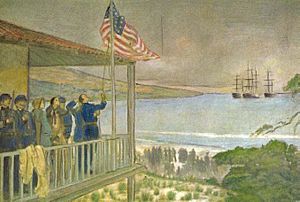Battle of Monterey facts for kids
Quick facts for kids Battle of Monterey |
|||||||
|---|---|---|---|---|---|---|---|
| Part of Conquest of California Mexican–American War |
|||||||
 Officers of Commodore Sloat raise the U.S. flag over Monterey |
|||||||
|
|||||||
| Belligerents | |||||||
| Commanders and leaders | |||||||
| John D. Sloat Earl Van Dorn |
Mariano Silva | ||||||
| Strength | |||||||
| 225 sailors and marines | unknown | ||||||
| Casualties and losses | |||||||
| None | None | ||||||
The Battle of Monterey happened in Monterey, California, on July 7, 1846. It was part of the Mexican–American War. The United States took control of the town without any fighting.
Why the Battle of Monterey Happened
This event was a key part of the Mexican–American War. It was also part of the Conquest of California, when the U.S. took control of California.
California's Situation Before the War
Before the war, California was a part of Mexico. However, local Californians, called Californios, had recently removed the Mexican governor, Manuel Micheltorena. They replaced him with a Californio governor, Pio Pico. This meant Mexico's control over California was not very strong.
The United States had a naval force called the Pacific Squadron. It was led by Commodore John D. Sloat. His ships carried about 400 to 500 sailors and U.S. Marines. Sloat had secret orders. If he was sure that war had started between the U.S. and Mexico, he was to capture San Francisco Bay. He was also told to block other California ports.
Commodore Sloat's Decision
In May 1846, Sloat heard that fighting had begun on the Rio Grande. He also learned about battles like Palo Alto and Resaca de la Palma. This news made him believe war had officially started.
He sailed his ship, the USS Savannah, towards California. He arrived in Monterey on July 1. Another U.S. ship, the USS Cyane, was already there.
Fears of British Involvement
The U.S. was worried that Britain might try to take California. Britain had more ships and soldiers in the Pacific at that time.
News of the Bear Flag Revolt
On July 5, Sloat received important news. He learned about the Bear Flag Revolt in Sonoma. This was when American settlers in California rebelled against Mexican rule. They raised a "Bear Flag" and declared their own republic. Sloat thought the leader of this revolt, Captain John C. Frémont, was acting on orders from Washington.
Because of this, Sloat decided it was time to act. On July 6, he decided to capture Monterey. He also ordered another commander to take control of Yerba Buena (which is now San Francisco).
The Capture of Monterey
On the morning of July 7, 1846, Commodore John D. Sloat led his ships to capture Monterey. His ships were the USS Savannah, USS Cyane, and USS Levant.
Seeking Surrender
At 7:30 a.m., Captain William Mervine went ashore from the Savannah. He asked the Mexican commander, Captain Mariano Silva, to surrender the port. Silva said he was "not authorized to surrender." In reality, Silva had no real soldiers or gunpowder for his cannons. The main Mexican forces were located inland.
Raising the U.S. Flag
At 10 a.m., 225 U.S. sailors and marines landed. They gathered in front of the Customs House. A U.S. officer read a statement from Commodore Sloat. It said that war existed between the U.S. and Mexico. It also declared that California would now be part of the United States.
The only "shots" fired were 21-gun salutes from each U.S. Navy ship. This was to honor the new U.S. flag flying over Monterey. British ships watched but did not get involved.
What Happened Next
After taking Monterey, Sloat made some important decisions. He respected Mexican land titles and church lands. He also set up new local leaders, called justices of the peace, when the Mexican officials resigned.
Spreading the News
On July 8, Captain Montgomery, another U.S. commander, received Sloat's order to take Yerba Buena (San Francisco). On July 9, Montgomery and 70 men landed there. They read the same statement that was read in Monterey. They then replaced the "Bear Flag" with the American flag. This was also celebrated with a 21-gun salute.
New Leadership and Forces
On July 15, Commodore Robert F. Stockton arrived in Monterey. He took over command from the older Commodore Sloat. British ships arrived in Monterey and Yerba Buena later, but they did not interfere.
On July 19, Captain Frémont and his group arrived in Monterey. Frémont met with Sloat. Sloat learned that Frémont had acted on his own, not on orders from Washington. This made Sloat concerned.
Frémont was then put in charge of the California Battalion. This was a group of American volunteers and soldiers. They were used to keep order in the towns that had surrendered.
Mexican Resistance Ends
The Americans now controlled northern California. Mexican General Castro and Governor Pico planned to fight back in the south. However, their army was small, lacked money, and didn't have much support. On August 11, they learned that the American army was advancing on Los Angeles. Castro and Pico then left California for Mexico. This meant the Mexican government in California had completely fallen.
See also
 In Spanish: Batalla de Monterrey (California) para niños
In Spanish: Batalla de Monterrey (California) para niños

